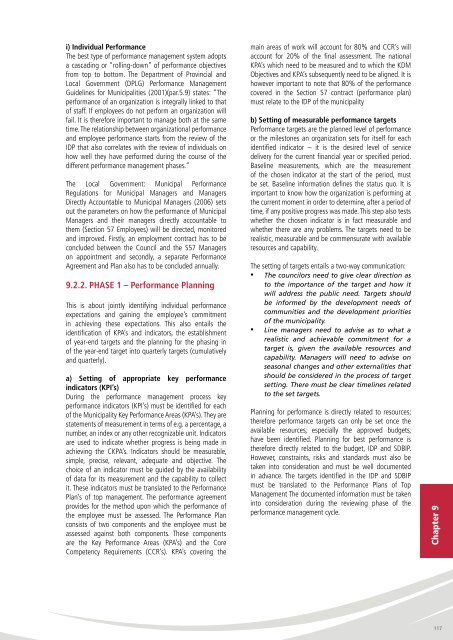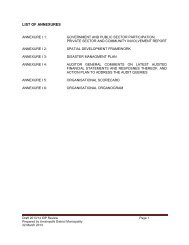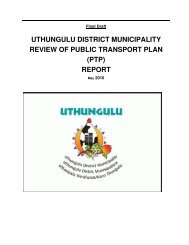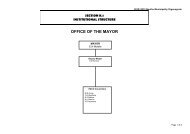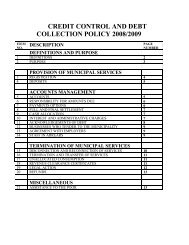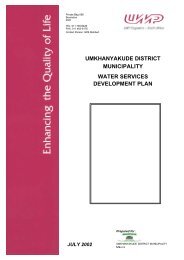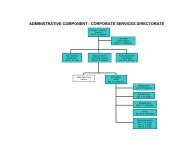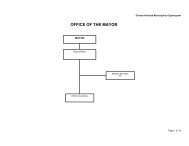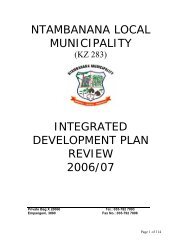Kwadukuza IDP 2011 - KZN Development Planning
Kwadukuza IDP 2011 - KZN Development Planning
Kwadukuza IDP 2011 - KZN Development Planning
Create successful ePaper yourself
Turn your PDF publications into a flip-book with our unique Google optimized e-Paper software.
i) Individual PerformanceThe best type of performance management system adoptsa cascading or “rolling-down” of performance objectivesfrom top to bottom. The Department of Provincial andLocal Government (DPLG) Performance ManagementGuidelines for Municipalities (2001)(par.5.9) states: “Theperformance of an organization is integrally linked to thatof staff. If employees do not perform an organization willfail. It is therefore important to manage both at the sametime. The relationship between organizational performanceand employee performance starts from the review of the<strong>IDP</strong> that also correlates with the review of individuals onhow well they have performed during the course of thedifferent performance management phases.”The Local Government: Municipal PerformanceRegulations for Municipal Managers and ManagersDirectly Accountable to Municipal Managers (2006) setsout the parameters on how the performance of MunicipalManagers and their managers directly accountable tothem (Section 57 Employees) will be directed, monitoredand improved. Firstly, an employment contract has to beconcluded between the Council and the S57 Managerson appointment and secondly, a separate PerformanceAgreement and Plan also has to be concluded annually.9.2.2. PHASE 1 – Performance <strong>Planning</strong>This is about jointly identifying individual performanceexpectations and gaining the employee’s commitmentin achieving these expectations. This also entails theidentification of KPA’s and indicators, the establishmentof year-end targets and the planning for the phasing inof the year-end target into quarterly targets (cumulativelyand quarterly).a) Setting of appropriate key performanceindicators (KPI’s)During the performance management process keyperformance indicators (KPI’s) must be identified for eachof the Municipality Key Performance Areas (KPA’s). They arestatements of measurement in terms of e.g. a percentage, anumber, an index or any other recognizable unit. Indicatorsare used to indicate whether progress is being made inachieving the CKPA’s. Indicators should be measurable,simple, precise, relevant, adequate and objective. Thechoice of an indicator must be guided by the availabilityof data for its measurement and the capability to collectit. These indicators must be translated to the PerformancePlan’s of top management. The performance agreementprovides for the method upon which the performance ofthe employee must be assessed. The Performance Planconsists of two components and the employee must beassessed against both components. These componentsare the Key Performance Areas (KPA’s) and the CoreCompetency Requirements (CCR’s). KPA’s covering themain areas of work will account for 80% and CCR’s willaccount for 20% of the final assessment. The nationalKPA’s which need to be measured and to which the KDMObjectives and KPA’s subsequently need to be aligned. It ishowever important to note that 80% of the performancecovered in the Section 57 contract (performance plan)must relate to the <strong>IDP</strong> of the municipalityb) Setting of measurable performance targetsPerformance targets are the planned level of performanceor the milestones an organization sets for itself for eachidentified indicator – it is the desired level of servicedelivery for the current financial year or specified period.Baseline measurements, which are the measurementof the chosen indicator at the start of the period, mustbe set. Baseline information defines the status quo. It isimportant to know how the organization is performing atthe current moment in order to determine, after a period oftime, if any positive progress was made. This step also testswhether the chosen indicator is in fact measurable andwhether there are any problems. The targets need to berealistic, measurable and be commensurate with availableresources and capability.The setting of targets entails a two-way communication:• The councilors need to give clear direction asto the importance of the target and how itwill address the public need. Targets shouldbe informed by the development needs ofcommunities and the development prioritiesof the municipality.• Line managers need to advise as to what arealistic and achievable commitment for atarget is, given the available resources andcapability. Managers will need to advise onseasonal changes and other externalities thatshould be considered in the process of targetsetting. There must be clear timelines relatedto the set targets.<strong>Planning</strong> for performance is directly related to resources;therefore performance targets can only be set once theavailable resources, especially the approved budgets,have been identified. <strong>Planning</strong> for best performance istherefore directly related to the budget, <strong>IDP</strong> and SDBIP.However, constraints, risks and standards must also betaken into consideration and must be well documentedin advance. The targets identified in the <strong>IDP</strong> and SDBIPmust be translated to the Performance Plans of TopManagement The documented information must be takeninto consideration during the reviewing phase of theperformance management cycle.Chapter 9117


